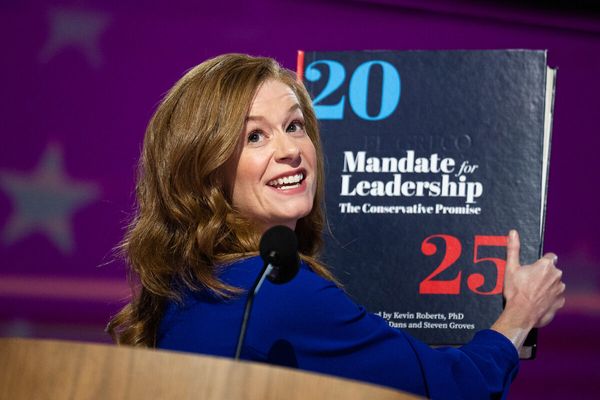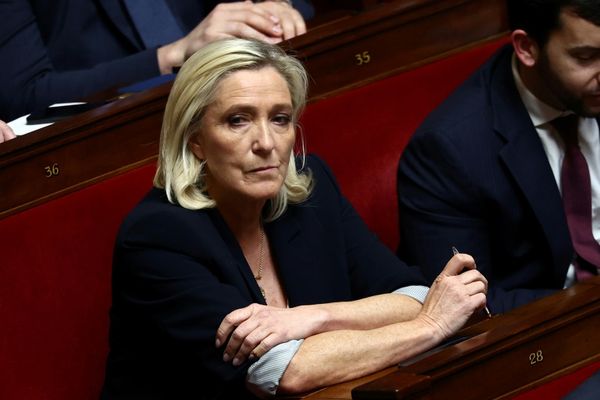
Within hours of taking office on 20 January, the US president, Donald Trump, announced an immediate 90-day freeze on all US foreign assistance, including over $40bn (£32bn) for international projects coming from USAid, the US Agency for International Development.
In that time, there would be a review conducted to ensure the agency was backing work that aligned with the administration’s “America First” agenda. Waivers were later announced for “lifesaving humanitarian assistance” but it was quickly apparent the guidelines were confusing and contradictory.
The chaos was then exacerbated by what had begun to take place at the USAid Washington offices.
By Friday 31 January, yellow tape surrounded the Pennsylvania Avenue headquarters, and members of the new Department of Government Efficiency (Doge), headed by billionaire Elon Musk, were inside.
On Saturday, USAid’s website disappeared and inside the building there were standoffs with staff over access to confidential data.
At 12.42am on Monday 3 February, staff received an email telling them not to come to work after a weekend that had seen much of the agency dismantled, its servers removed and leadership and senior staff fired or put on disciplinary leave. Musk wrote on X, the social media site he owns: “We spent the weekend feeding USAid into the woodchipper.”
Trump’s new head of the state department, Marco Rubio, announced he was now the administrator of USAid. The same day, Trump told reporters that shutting down USAid “should have been done a long time ago”. Asked whether he needed Congress to approve such a measure, the president said he did not think so.
On Tuesday 4 February, the administration said that nearly all 10,000 USAid employees were on leave, and the two-thirds of that number who were working overseas would be recalled.
Democratic senator Chris Murphy said: “This is a constitutional crisis we are in today.”
The sudden dismantling of USAid has sent shock waves through 177 recipient countries. Critical supplies of medicine have stopped abruptly and children have been left without food, health workers have been sacked as programmes and treatment centres have been shut down, including those set up to tackle HIV in 50 countries. An HIV vaccine trial in South Africa has been cancelled. Efforts to eradicate polio, malaria and tuberculosis have also been affected.
Local people have lost their jobs and supplies of food and medicine have been left rotting in warehouses. In Khartoum in Sudan, a country where more than half of the population are going hungry, two-thirds of soup kitchens have shut their doors.
In places from Ukraine to Afghanistan independent news organisations have had to lay off journalists. Analysis from the Guttmacher Institute estimates that 130,00o women have been denied contraceptives each day of the freeze, a total of 3.4 million. The International Rescue Committee has cut jobs with other international aid organisations expected to follow suit.
What is USAid and why is it so important?
The state agency was founded in 1961 by President John F Kennedy in the middle of the cold war. It was established to underpin the US’s security and bolster its standing against Soviet influence by providing aid to struggling countries, and to respond to emergencies from famine to diseases such as polio and smallpox.
Its responsibilities, budget and independence have been fought over by Republicans and Democrats ever since. The US reportedly provided 40% of all humanitarian aid accounted for by the UN in 2024 and spends about $72bn on aid each year, $40bn of which is distributed through USAid.
One programme, the Pepfar initiative (president’s emergency plan for Aids relief, set up by President George W Bush), has invested $110bn worldwide to tackle Aids, and is often cited as one of the biggest health success stories of recent times.
Why do Trump and Musk want to stop it?
Donald Trump, a longtime critic of overseas aid, has argued that its spending is “totally unexplainable … close it down!” and that it doesn’t fit with his “America first” agenda. Musk has falsely accused it of being a “criminal organisation” that needs to “die”. The White House has published a list of US aid programmes it says are evidence of “waste and abuse” but fact checkers have questioned much on the list.
It is clear from the executive order that the administration sees dismantling international aid as a way to extend its internal culture war against progressive policies. The “foreign aid industry and bureaucracy” were in many cases “antithetical to American values” the order on aid said. “They serve to destabilize world peace by promoting ideas in foreign countries that are directly inverse to harmonious and stable relations internal to and among countries.”
How much does the US spend – and how does this compare with other G7 countries?
The US government spent $72bn in foreign aid in 2023, according to Foreign Assistance.gov, more than $40bn of which was administered by USAid. In 2023, foreign aid amounted to 1.2% of the federal budget of 6.1tn.
Although the largest donor, the US spends less by percentage of its national income on aid than all other G7 countries, at 0.24%. The UK, for instance, spends 0.58% of its national income on aid.
What is US aid used for?
In 2023, more than $40bn of the total $72bn of US foreign assistance was distributed by USAid, the remainder was administered by the state department. That year, the largest sector spend of all foreign aid was “economic development” at $19.4bn, most of which ($14.6bn) went to Ukraine. Disaster relief and other humanitarian aid to various countries made up 21.7%, or $15.6bn. Health took up 22.3%,or $16bn, $10.6 of which went towards combating HIV and Aids.
Who receives the most?
All of the US foreign assistance budgets supported 209 countries and territories in 2023. The top five largest recipients were Ukraine at $16.6bn, Israel with $3.3bn, Ethiopia at $1.8bn, Jordan, $1.7bn, and Egypt at $1.4bn.
Are there any exemptions?
On 28 January, waivers to the funding freeze were issued by the US state department for “lifesaving” humanitarian assistance, including “core lifesaving medicine” and “medical services, food, shelter and subsistence”. Two weeks after the freeze was imposed, on 6 February, the waiver was clarified to include HIV care and treatment services, prevention of mother-to-child transmission services and associated administrative costs. But by then, it had already affected prevention programmes and many projects had closed. The payment system that USAid relies on to distribute assistance has also been closed down, so even those programmes with exemptions cannot continue.
Is it legal to dismantle USAid?
Legal challenges have already begun, while more are in the pipeline. Last week a federal judge ordered the Trump administration to temporarily lift the funding freeze on USAid, citing the financial devastation caused to aid groups and suppliers. In a separate ruling, a judge temporarily blocked the Trump administration from placing 2,200 USAid employees on leave, after hearing arguments that the administration lacked the authority to shut down an agency enshrined in congressional legislation.







